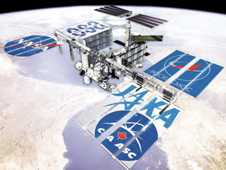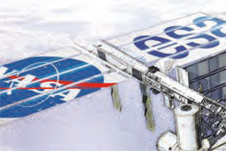By Jean-Jacques Dordain
The director general of the European Space Agency says the future of space exploration depends on global cooperation.

Forty years after the first landing on the moon by two American astronauts, the significance of that historical step of human exploration is very different from what it was at that time. Then, it was a clear demonstration of the supremacy of U.S. technology over the world, and a symbol of the U.S. identity. Forty years later, it is not anymore a matter of the moon and the United States, but rather of planet Earth and humankind; twenty-seven astronauts have seen planet Earth as a small and fragile golf ball floating in the universe and, as a result, helped develop the understanding that our future can only be global.
Thanks to that first landing on the moon, we have witnessed two paradigm shifts. The first is about the objective, which has shifted from space to planet Earth. The compelling urge of man to explore and discover is not enough to justify engaging in long-term exploration. There is a need, at least in Europe—it may be different in other societies—to identify benefits of space exploration able to generate a resilient political and public support, which is a condition for space exploration to be sustainable over the years. The benefits must be measurable on Earth: economic growth, technological innovation, scientific information, international cooperation, education, all of which can contribute to solving problems here. Exploration addresses the future of planet Earth.
Future space exploration can indeed only be global, and it will require us to assemble the nations that explored individually in the past to explore collectively in the future.
The second paradigm shift is about the process, which has moved from competition to cooperation. We have started with one flag on the moon, then two flags for the Apollo Soyuz mission, then four with Space Station Freedom, and now five flags for the International Space Station (ISS). The cooperative process may be much slower than the competitive race, but it is also much more robust and sustainable.
Future space exploration can indeed only be global, and it will require us to assemble the nations that explored individually in the past to explore collectively in the future. This is not easy. It will be the most difficult part of exploration, much more difficult than any required technological development, but it is necessary. There is no alternative. We shall have to invent the future together. Because it will not be easy, we will have to go there in steps. I see three major steps: make the utilization of the ISS a success for exploration, develop robotic exploration plans, and define a human exploration scenario.
Make ISS Utilization a Success
 The recent decision taken by President Obama to extend the operation of ISS to 2020 and beyond is very good news for all partners. As NASA Administrator Charlie Bolden has said, we were waiting for that decision and even asking for that decision. These next ten years are necessary to make ISS utilization a success, to demonstrate to the public and governments that they were right to invest in it. Also, we need time to reap the benefits, be it for science, for technologies, or for new partnerships. As I said to the Augustine Committee, we shall not build exploration on the failure of the ISS. So our first priority shall be to ensure the success of ISS.
The recent decision taken by President Obama to extend the operation of ISS to 2020 and beyond is very good news for all partners. As NASA Administrator Charlie Bolden has said, we were waiting for that decision and even asking for that decision. These next ten years are necessary to make ISS utilization a success, to demonstrate to the public and governments that they were right to invest in it. Also, we need time to reap the benefits, be it for science, for technologies, or for new partnerships. As I said to the Augustine Committee, we shall not build exploration on the failure of the ISS. So our first priority shall be to ensure the success of ISS.
These next ten years will provide time and perspective to improve the ISS and make it a concrete step toward exploration. The decision not only represents five additional years of exploitation, it also provides a perspective long enough for all partners to think about new ideas, new approaches, and new hardware. The two questions we should now ask ourselves are how to increase the benefits of the ISS, and how to decrease the costs of using it.
How can we increase the benefits of the ISS? These are some of the possibilities:
- Increasing capabilities, not by adding new labs, but by reducing bottlenecks such as storage, communications, or download;
- Extending the range of scientific utilization toward new fields such as Earth observation, monitoring of natural disasters, climate change;
- Improving operations, for instance through a common transportation policy or a common operations policy—that is, defining common interfaces between each partner’s elements;
- Testing new systems and technologies, for instance in the fields of life support or resources recycling;
- Extending the partnership to other partners, on conditions to be defined. To be sustainable, the space station partnership cannot be closed.
How can we decrease the costs of ISS utilization?
The objective is to decrease the costs of production and operations in order to rebalance development and production activities. The use of commercial services is one interesting track—not the only one, but a track that requires the space agencies to think and to adapt.
My biggest fear as the director general of the European Space Agency (ESA) is that ESA could become a dinosaur, no longer adapted to its environment. We have to change, continuously. This is not easy, in particular because we are a successful agency, and it is easy to keep doing what has made us successful. But the future will not be made with the recipes of the past.
Commercial services may indeed be one way. We have already experienced that in Europe, by creating the commercial operator Arianespace for launch services, but that was thirty years ago. Reflections are ongoing to see how we can adapt this scenario for the future.
We should not forget, however, that the customer for the ISS and exploration is and will remain governments, not private organizations. I refuse the much too simple statement that agencies are expensive and industry is cheap. The reality is as usual much more complex: agencies work under substantial constraints imposed by their governments, such as distribution of activities, but agencies can also be cheaper, and we in ESA shall work together with the other agencies to reduce significantly utilization costs. Agencies cannot do without industry, but industry also cannot do without agencies.
Any progress made for the utilization of the ISS will be a progress made for exploration. The ISS will be valued also by its capacity to support exploration.
The space station is the first step in human exploration beyond low-Earth orbit!
Develop Robotic Exploration Plans
 Last year, ESA and NASA made a significant step by taking a joint initiative for a systematic robotic exploration of Mars; we have decided to use every opportunity to go to Mars together, and we have already defined joint missions that will be launched in 2016 and 2018. The ultimate goal is a joint Mars sample return in the mid-2020s. There, also, the partnership is not closed and must be open to other partners.
Last year, ESA and NASA made a significant step by taking a joint initiative for a systematic robotic exploration of Mars; we have decided to use every opportunity to go to Mars together, and we have already defined joint missions that will be launched in 2016 and 2018. The ultimate goal is a joint Mars sample return in the mid-2020s. There, also, the partnership is not closed and must be open to other partners.
Beyond this Mars robotic exploration plan, other robotic missions should be planned as precursors to human exploration, around or on the surface of other destinations such as the moon or asteroids. Such missions should provide detailed information on the topography and geochemical properties of the surface of these destinations, and allow the testing of possibilities and techniques for “living off the land.”
A major interest of robotic investigation is to involve industrial expertise outside the traditional space industry and, therefore, to widen the base of stakeholders and increase the synergy between space-bound and Earth-bound interests.
Define a Human Space Exploration Scenario
As Administrator Bolden has noted, there is no common vision among international partners about a human space-exploration scenario beyond the exploitation of the ISS. The U.S. Constellation program is being terminated, though the United States remains committed to explore beyond low-Earth orbit. In Europe we are currently reflecting on our future human exploration plans. Other partners may have plans, but they are individual plans rather than a contribution to a global scenario.
A global exploration strategy has been developed by fourteen space agencies, including ESA. But this global exploration strategy has not been addressed at a political level and does not represent a political strategy shared by an enlarged community of international partners.
A high-level political forum, including current partners as well as potential new partners of the ISS, should be set up with the objectives of developing a common vision for exploration. At the space-agency level, we can develop a common architecture for human space exploration. But we can’t develop the political vision. We are waiting for someone to take the initiative. Which partner in the world has the willingness and credibility to propose such a political forum? I am convinced that the United States is the best suited to take such an initiative … but when?
As the French author and aviator Saint-Exupry said, “… the question about the future is not to predict it, but to make it possible.” So let us work together to make it possible.
About the Author
 |
Jean-Jacques Dordain is the director general of the European Space Agency. |






